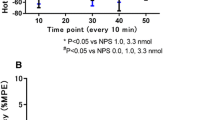Abstract
Intrathecal injection of metergoline reduced the response latencies in the tail-flick and hot-plate tests, supporting the contention that descending 5-hydroxytryptamine (5-HT) pathways tonically inhibit pain sensitivity. Elevated latencies were, however, observed after both intraperitoneal (IP) and intracerebroventricular (ICV) injections in the hot-plate test, when hindpaw lick was used as the response criterion. These findings may indicate that supraspinal 5-HT pathways tonically increase pain responsiveness in certain test situations. Alternative hypotheses are that metergoline in supraspinal structures acts as an agonist at post-synaptic 5-HT receptors mediating antinociception, or as an antagonist at pre-synaptic 5-HT receptors. Recording of first reaction latencies on the hot-plate showed increased thresholds after IP, but not after ICV injections. This may indicate an action on 5-HT receptors in the brain not accessible after ICV injections, or that the effect is mediated by blockade of peripheral 5-HT receptors.
Similar content being viewed by others
References
Baumann PA, Waldmeier PC (1981) Further evidence for negative feedback control of serotonin release in the central nervous system. Naunyn-Schmiedeberg's Arch Pharmacol 317:36–43
Beretta C, Glasser AH, Nobili MB, Silvestri R (1965) Antagonism of 5-hydroxytryptamine-induced bronchospasm in guinea-pigs by 8β-carbobenzyloxyaminomethyl-1,6-dimethyl-10α-ergoline. J Pharm Pharmacol 17:423–428
Berge O-G (1982) Effects of 5-HT receptor agonists and antagonists on a reflex response to radiant heat in normal and spinally transected rats. Pain 13:253–266
Berge O-G, Fasmer OB, Flatmark T, Hole K (1983a) Time course of changes in nociception after 5,6-dihydroxytryptamine lesions of descending 5-HT pathways. Pharmacol Biochem Behav 18:636–643
Berge O-G, Fasmer OB, Hole K (1983b) Serotonin receptor antagonists induce hyperalgesia without preventing morphine antinociception. Pharmacol Biochem Behav 19:873–878
Bourgoin S, Artaud F, Bockaert J, Hery F, Glowinski J, Hamon M (1978) Paradoxical decrease of brain 5-HT turnover by metergoline, a central 5-HT receptor blocker. Naunyn-Schmiedeberg's Arch Pharmacol 302:313–321
Colpaert FC, Niemegeers CJE, Janssen PAJ (1979) In vivo evidence of partial agonist activity exerted by purported 5-hydroxytryptamine antagonists. Eur J Pharmacol 58:505–509
D'Amour FE, Smith DL (1941) A method for determining loss of pain sensation. J Pharmacol Exp Ther 72:74–79
Eddy NB, Leimbach D (1953) Synthetic analgesics. II. Dithienyl-butenyl-and dithienylbutylamines. J Pharmacol Exp Ther 107:385–393
Ennis C, Cox B (1982) Pharmacological evidence for the existence of two distinct serotonin receptors in rat brain. Neuropharmacology 21:41–44
Ennis C, Kemp JD, Cox B (1981) Characterisation of inhibitory 5-hydroxytryptamine receptors that modulate dopamine release in the striatum. J Neurochem 36:1515–1520
Fuxe K, Agnati L, Everitt B (1975) Effects of methergoline on central monoamine neurones. Evidence for a selective blockade of central 5-HT receptors. Neurosci Lett 1:283–290
Griersmith BT, Duggan AW, North RA (1981) Methysergide and supraspinal inhibition of the spinal transmission of nociceptive information in the anaesthetized cat. Brain Res 204:147–158
Göthert M (1980) Serotonin-receptor-mediated modulation of Ca2+-dependent 5-hydroxytryptamine release from neurones of of the rat brain cortex. Naunyn-Schmiedeberg's Arch Pharmacol 314:223–230
Haigler HJ, Aghajanian GK (1974) Peripheral serotonin antagonists: Failure to antagonize serotonin in brain areas receiving a prominent serotonergic input. J Neural Transm 35:257–273
Haley TJ, McCormick WG (1957) Pharmacological effects produced by intracerebral injection of drugs in the conscious mouse. Br J Pharmacol 12:12–15
Herman ZS (1975) Behavioural changes induced in conscious mice by intracerebroventricular injection of catecholamines, acetylcholine and 5-hydroxytryptamine. Br J Pharmacol 55:351–358
Hole K, Lorens SA (1975) Response to electric shock in rats: Effects of selective midbrain raphe lesions. Pharmacol Biochem Behav 3:95–102
Hole K, Fuxe K, Jonsson G (1976) Behavioural effects of 5,7-dihydroxytryptamine lesions of ascending 5-hydroxytryptamine pathways. Brain Res 107:385–399
Hylden JLK, Wilcox GL (1980) Intrathecal morphine in mice: A new technique. Eur J Pharmacol 67:313–316
Lin M-T, Chandra A, Chi M-L, Kau C-L (1980) Effects of increasing serotonergic receptor activity in brain on analgesic activity in rats. Exp Neurol 68:548–554
Malec D, Langwinski R (1980) The influence of 5-HT receptor blocking agents on the behavioural effects of analgesics in rats. Psychopharmacology 69:79–83
Messing RB, Lytle LD (1977) Serotonin-containing neurons: Their possible role in pain and analgesia. Pain 4:1–21
Mounsey I, Brady KA, Carroll J, Fisher R, Middlemiss DN (1982) K+-evoked [3H]-5-HT release from rat frontal cortex slices: The effect of 5-HT agonists and antagonists. Biochem Pharmacol 31:49–53
Nakano T, Taira N (1976) 5-Hydroxytryptamine as a sensitizer of somatic nociceptors for pain-producing substances. Eur J Pharmacol 38:23–29
Proudfit HK (1980) Reversible inactivation of raphe magnus neurons: effects on nociceptive threshold and morphine-induced analgesia. Brain Res 201:459–464
Proudfit HK, Hammond DL (1981) Alterations in nociceptive threshold and morphine-induced analgesia produced by intrathecally administered amine antagonists. Brain Res 218:393–399
Rochat C, Cervo L, Romandini S, Samanin R (1982) Differences in the effects of d-fenfluramine and morphine on various responses of rats to painful stimuli. Psychopharmacology 76:188–192
Samanin R, Bernasconi S, Quattrone A (1976) Antinociceptive action of quipazine: Relation to central serotonergic receptor stimulation. Psychopharmacologia 46:219–222
Sastry BSR, Phillis JW (1977) Metergoline as a selective 5-hydroxytryptamine antagonist in the cerebral cortex. Can J Physiol Pharmacol 55:130–133
Simansky KJ, Harvey JA (1981) Altered sensitivity to footshock after selective serotonin depletion: Comparison of electrolytic lesions and neurotoxin injections in the medial forebrain bundle of the rat. J Comp Physiol Psychol 95:341–350
Soja PJ, Sinclair JG (1980) Evidence against a serotonin involvement in the tonic descending inhibition of nociceptor-driven neurons in the cat spinal cord. Brain Res 199:225–230
Spano PF, Biggio G, Casu M, Gessa GL, Bareggi SR, Govoni S, Trabucchi M (1978) Interaction of metergoline with striatal dopamine system. Life Sci 23:2383–2392
Yaksh TL, Wilson PR (1979) Spinal serotonin terminal system mediates antinociception. J Pharmacol Exp Ther 208:446–453
York JL, Maynert EW (1978) Alterations in morphine analgesia produced by chronic deficits of brain catecholamines or serotonin: Role of analgesimetric procedure. Psycho-pharmacology 56:119–125
Author information
Authors and Affiliations
Rights and permissions
About this article
Cite this article
Fasmer, O.B., Berge, O.G. & Hole, K. Metergoline elevates or reduces nociceptive thresholds in mice depending on test method and route of administration. Psychopharmacology 82, 306–309 (1984). https://doi.org/10.1007/BF00427675
Received:
Accepted:
Issue Date:
DOI: https://doi.org/10.1007/BF00427675



